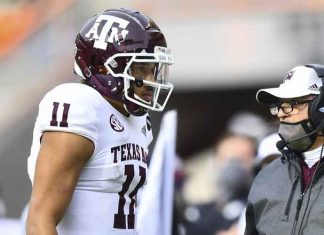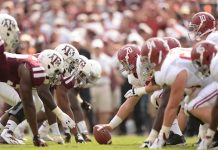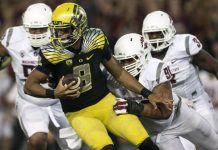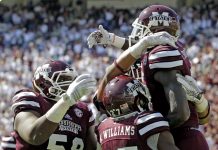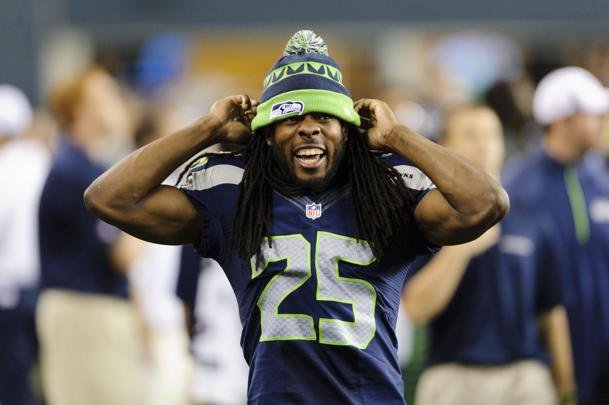(Stats Perform) – Even though the national news has grown more dire in the last month, Dr. Charles McClelland, commissioner of the Southwestern Athletic Conference, was stunned by an update last week.
He almost couldn’t believe the White House coronavirus response team’s estimate of 100,000 to 240,000 possible deaths in the United States even if Americans follow the recommended measures to stop the spread of COVID-19.
“My concern has increased,” Dr. McClelland said.
“Those numbers are alarming.”
So alarming that stakeholders across college sports such as Dr. McClelland – and in many sports – are developing contingency plans in case COVID-19 continues to disrupt the games this fall. The pandemic ended the postseason in winter sports and the majority of the spring sports season.
Commissioners, athletic directors, coaches and, well, just about everybody are trying to remain optimistic fall sports won’t be delayed or eliminated. They’re led by football, which generates the largest revenue at most institutions and helps to fund other athletic teams.
The FCS level of college football – the lower half of Division I, which includes 126 schools from the SWAC and 12 other conferences – is considering all models for the fall, and it may have to wait on the decisions of FBS conferences in the upper half because the larger-school membership will have the loudest voices in evolving decisions. Big 12 commissioner Bob Bowlsby recently admitted “the fall is in jeopardy.”
“I think it’s too soon to speculate about fall sports, full or partial seasons,” Northeast Conference commissioner Noreen Morris said last week. “I think we’ll have a better understanding in early May as to the state of higher education in general in terms of fall enrollment. Once we know if (and) when institutions will open their doors, we’ll be able to start planning for the resumption of practices and competition.”
“I’m very hopeful we will have fall sports,” said Dr. Brad Teague, the athletic director at the University of Central Arkansas. “I have confidence we, as a country, will have procedures in place to allow us to resume normal activities by late summer. This may cause us to have an altered schedule in the fall, but I am hopeful this will happen. However, I am aware that contingency plans will need to be in place.”
Added North Dakota State athletic director Matt Larsen, whose football program has won three straight national titles, “I think we are still very optimistic and are planning for all fall sports to go off as normal. So much of that decision will really depend on the next month to six weeks. If we aren’t returning to some normalcy by June, then I would be concerned we would be looking at shortened, adjusted or no fall competitions. We are working through some contingency plans in regard to facility availability – if the season got pushed out – games with fans and without fans, shortened season, etc.”
The scheduled start of games is less than five months away, but that doesn’t include preseason training camps, which start in late July or early August. Everybody has a different timeline for making decisions about having a full, truncated or no season.
An optimistic Joe D’Antonio, the Colonial Athletic Association commissioner, believes, “Time is on our side. A little bit of planning is never harmful.
“I think we are very cautiously optimistic that we are going to be able to have normal fall season,” he added. “If we can get back to a normal situation by Aug. 1, that may, and I stress the word ‘may,’ allow for a full season interrupted.”
Said Patty Viverito, the commissioner of both the Missouri Valley Football Conference and Pioneer Football League: “When you’re talking about fall sports, and especially football, you’re not just talking about when the first contest date is, but you have to back that up in a way for preseason practice that ensures that football student-athletes are ready to play from a health and safety standpoint – they have to be conditioned. I’ve heard a lot of different thoughts about how much time that would require, and I would imagine that the NCAA would not take any shortcuts to that regard.”
Any changes in football that bring on additional financial loss could be debilitating at some schools, especially from the FCS level on down. The NCAA says the loss of March Madness – the national basketball showcase – has cost it about $375 million. Instead of distributing about $600 million to over 1,200 schools across all divisions, the NCAA will now distribute $225 million.
Financial shortfalls in state education budgets would make the situation even worse.
“Regarding finances, it is a difficult, and in some ways, scary time,” Big South Conference commissioner Kyle Kallander said. “I am more concerned about the overall impacts on our institutions than athletics specifically. The enrollment pressures on higher education were already very real. Add on to that the financial impacts of COVID to the economy and our institutions, and it is very problematic. Again, thinking positively, we hope this is a short-term hit. However, I do believe the current environment will cause permanent changes in institutions’ abilities to provide the same opportunities as before due to the combination of these factors.”
Southland Conference commissioner Tom Burnett said, “It’s good to note that if things get back to ‘normal’ in the next year, the NCAA revenue should return to levels we are more accustomed to. And much of that revenue is applied to a number of sports sponsored and total number of scholarships at our institutions.”
Even the most hopeful decision-makers are brainstorming ways to cut expenses, model different scenarios and work through harsh reality. A shorter season could mean keeping conference games and eliminating nonconference matchups. FCS schools would be reluctant to sacrifice games against FBS schools, where financial guarantees can equal or surpass a season’s worth of home games. Ultimately, any and all games revolve around government assurances that COVID-19 is coming under control.
Which brings everybody back to the news that change by the day, if not the hour. Good, bad and sometimes shocking, as Dr. McClelland could confirm last week.
“I think whatever trend is going on (across the sports world) will definitely be studied and considered,” he said. “But I think the decisions we make have to make sense. What I’m getting from the NCAA is we are having an abundance of caution.”
25% Bonus via Western Union



